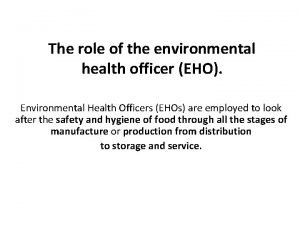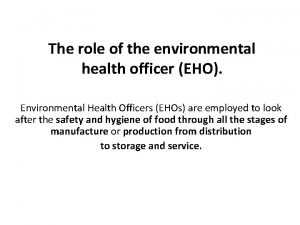The role of the environmental health officer EHO




- Slides: 4

The role of the environmental health officer (EHO). Environmental Health Officers (EHOs) are employed to look after the safety and hygiene of food through all the stages of manufacture or production from distribution to storage and service.

Environmental Health Officers (EHOs) enforce many Acts (laws). These include: 1. The Food Safety Act. • This covers food safety from the manufacturer or producer to the point of sale. This might involve different companies or premises e. g. suppliers, manufacturers or kitchens, shops or restaurants. 2. The Food Composition Regulations. • This specifies what ingredients CAN or CANNOT be used in the manufacture of foods e. g. bread, breakfast cereals and use of additives. 3. The Food Safety Act (General Food Hygiene) Regulations. • This ensures food producers HANDLE all food hygienically.

Environmental Health Officers (EHOs) enforce many Acts (laws). These include: 4. The Food Safety Act (Temperature Control) Regulations. These identify: • Specific temperatures at which to store or hold food. • Freezers from – 18°C to – 24°C • Chillers from 3°C to 8°C • Fridges from 1°C to 5°C • Cooked core temperature at 75°C or above • Hot holding above 63°C

Environmental Health Officers (EHOs) will look at: • Staff – properly dressed, clean nails, no jewellery, hair covered or tied back, good hygiene habits. • Processes in the work place – handling of food, use of equipment, use of colour coded boards, washing up, disposal of waste. • Storage of food – fridges, freezers and dry stores. Are they the correct temperature, clean, tidy and orderly? Does the kitchen have good systems in place, e. g. stock rotation and temperature logs? • Equipment – this should be clean, well maintained and with safety notices if appropriate. • Temperature of Foods – the use of probes to check food is at the correct temperature. • Think of an EHO as ‘Mr Nosey’. He/she will look at everything to make sure food is safe and not going to give a customer food poisoning. This ensures food producers HANDLE all food hygienically.







